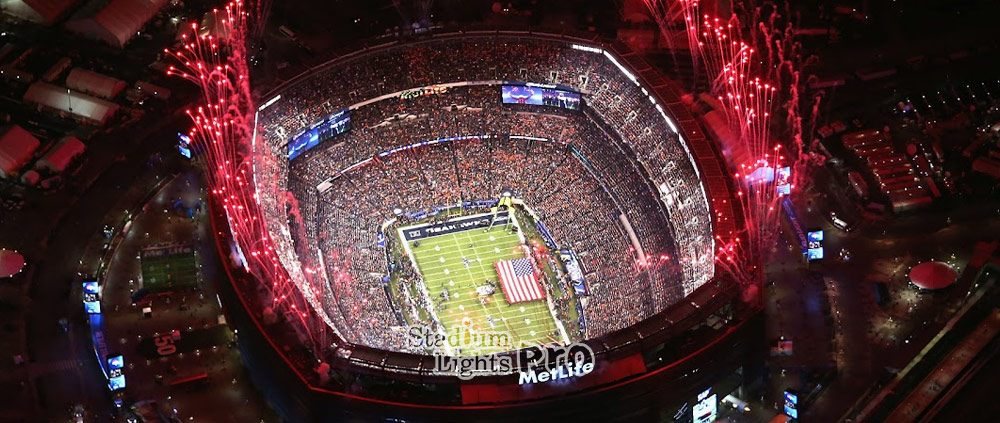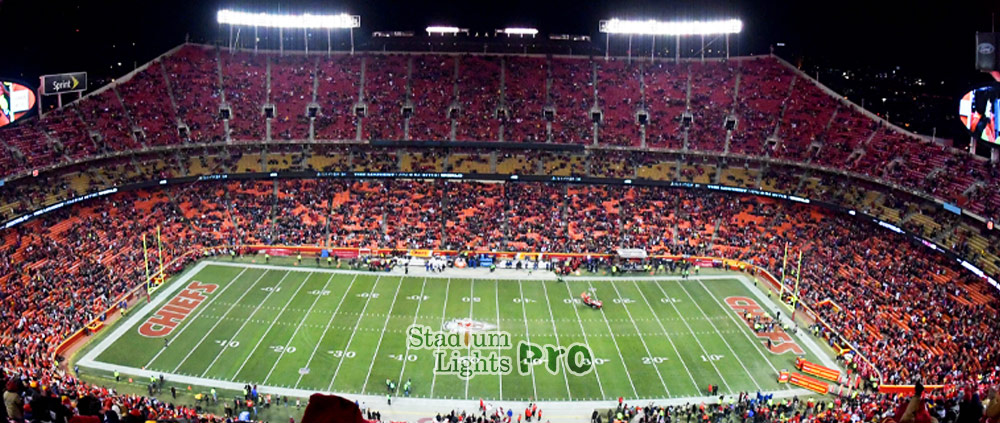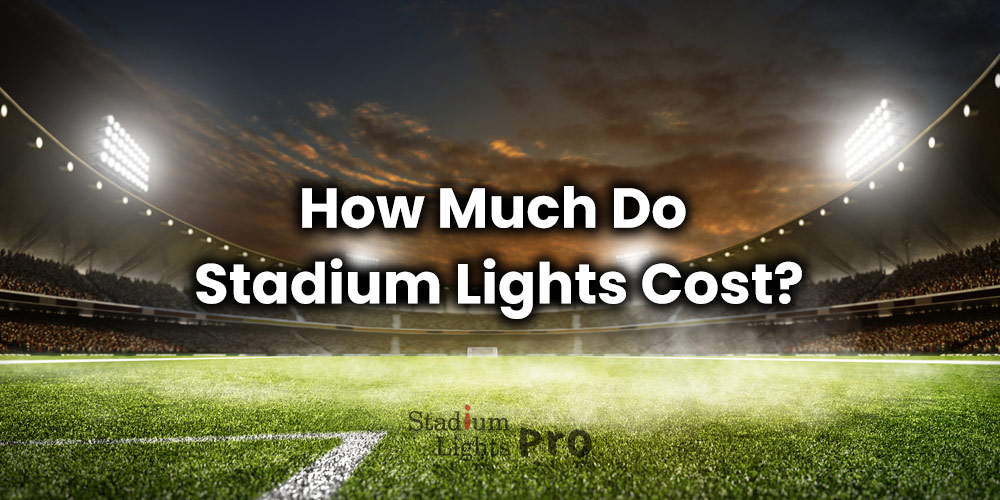The cost of lighting a football stadium will depend on several factors, including the size of the stadium, the type of lighting equipment used, the intensity of the lighting needed, and the duration of the event. According to our research, the cost of stadium lighting can range from $30,000 to $200,000.
Table of Contents
ToggleHow much does it cost to buy and install stadium lights?
The cost of buying and installing stadium lights can vary widely depending on a number of factors, including the size and location of the stadium, the type of lighting system, and the amount of electrical work that needs to be done.
To give you a rough estimate, here are a few assumptions and a calculation:
- Stadium size: 20,000 seat capacity
- Lighting system: LED lights with an average cost of $1,000 per fixture
- Electrical work: $50,000 for installation and wiring
Under these assumptions, the total cost of buying and installing stadium lights would be:
20,000 seat capacity / 500 seats per fixture * $1,000 per fixture = $40,000 for lighting fixtures
$40,000 for lighting fixtures + $50,000 for electrical work = $90,000 total cost
Keep in mind that this is just a rough estimate and the actual cost could be significantly higher or lower depending on the specific circumstances of your project. It’s always best to get quotes from multiple contractors to get a more accurate idea of the cost.
How much does it cost to run stadium lights?
Stadium A – annual running cost
Let’s assume that the stadium is a medium-sized facility with a seating capacity of 50,000. The stadium lighting fixtures are LED and the intensity of the lighting is sufficient for night time sporting events. The stadium is located in a city with an average cost of electricity of $0.12 per kilowatt-hour. The stadium is used for approximately 10 night time events per year.
Based on these assumptions, we can calculate the approximate cost to run the stadium lights as follows:
First, we need to determine the total number of lighting fixtures needed for the stadium. This will depend on the size of the stadium and the intensity of the lighting. For this example, let’s assume that the stadium requires 100 lighting fixtures.
Next, we need to determine the wattage of each lighting fixture. This will depend on the type of lighting fixture being used and the intensity of the lighting. For this example, let’s assume that each lighting fixture has a wattage of 1,000 watts.
Now, we can calculate the total wattage required to light the stadium by multiplying the number of lighting fixtures by the wattage of each fixture: 100 lighting fixtures * 1,000 watts/fixture = 100,000 watts
To calculate the cost to run the lights, we need to determine the total number of hours the lights will be used each year. For this example, let’s assume that each event lasts for 3 hours, for a total of 3 hours/event * 10 events/year = 30 hours/year.
Finally, we can calculate the cost to run the lights by multiplying the total wattage by the number of hours the lights will be used, and then by the cost of electricity: (100,000 watts * 30 hours/year) * $0.12/kilowatt-hour / 1000 = $360/year
Based on these assumptions, it would cost approximately $360 per year to run the stadium lights. This is just a rough estimate and the actual cost could vary significantly depending on the specific details of the stadium and lighting system.
Stadium B – daily running cost
Here is a rough estimate of the cost to run stadium lights based on some assumptions:
- Type of lights: LED lights
- Power consumption: 400W per light
- Number of lights: 100 lights
- Length of time used: 6 hours per day
- Electricity cost: $0.12 per kWh
Using these assumptions, the cost to run the stadium lights for one day would be:
400 W/light * 100 lights * 6 hours/day * $0.12/kWh = $28.8/day
This is just a rough estimate and the actual cost could vary significantly depending on the specific details of your situation.
What factors affect the cost of stadium lighting?
Here is a general outline of some of the factors that can affect the cost of lighting a football stadium:
Size of the stadium

The larger the stadium, the more lighting equipment will be needed to properly illuminate the field and seating areas. This will increase the overall cost of lighting the stadium.
The size of the stadium is typically measured by the number of seats it can accommodate. For example, a stadium with a seating capacity of 50,000 will require more lighting equipment than a stadium with a seating capacity of 20,000.
The size of the field can also be a factor. A larger field will require more lighting equipment to adequately cover the entire surface, which will increase the cost.
It is vital to consider the size of the stadium when planning the lighting for an event, as this will help to ensure that the venue is adequately lit while also minimizing costs.
Type of lighting equipment
There are several different types of lighting equipment that can be used to light a football stadium, including incandescent bulbs, fluorescent bulbs, and LED bulbs. Each type of lighting equipment has its own costs, with LED bulbs generally being more energy efficient and longer lasting, but also more expensive upfront.
Incandescent bulbs
Incandescent bulbs are the most traditional type of lighting used in football stadiums. They produce a warm, amber light that is similar to natural sunlight, but they are not as energy efficient as other types of lighting and need to be replaced more frequently.
Fluorescent lights
Fluorescent lights are a more energy efficient option than incandescent bulbs. They produce a cool, white light that is brighter than incandescent bulbs, but they may not be as durable as other types of lighting.
LED floodlights
LED floodlights are the most energy efficient and longest lasting type of lighting equipment. They produce a bright, white light that is similar to natural daylight, and they can last for many years before needing to be replaced. However, they may be more expensive upfront than other types of lighting.
When choosing lighting equipment for a football stadium, we should consider the specific needs of the venue and the preferences of the organizers. Factors such as the intensity of the lighting needed, the duration of the event, and the budget available will all influence the decision.
Intensity of lighting

The intensity of the lighting needed will depend on the requirements of the event and the preferences of the organizers. Higher intensity lighting will require more energy, which will increase the cost.
The lighting intensity needed for a football stadium will depend on the specific requirements of the event and the preferences of the organizers. Higher intensity lighting will require more energy, which will increase the cost.
It is typically measured in terms of the amount of light produced, or the luminous flux. This is usually measured in units of lumens. The higher the number of lumens, the brighter the light will be.
The intensity of the lighting can also be affected by other factors, such as the color temperature of the light. Color temperature is a measure of the hue of the light, with lower numbers indicating a warmer, more yellow light and higher numbers indicating a cooler, more blue light.
Duration of the event
The longer the event, the more energy will be used to light the stadium, which will increase the cost.
For example, if the event is a single football game that lasts for about three hours, the cost of lighting the stadium will be lower than if the event is a series of games that last for an entire weekend.
We need to consider the duration of the event when planning the lighting for a football stadium, as this will help to ensure that the venue is adequately lit while also minimizing costs. It may be more cost effective to turn off the lighting between events, or to use lower intensity lighting when the venue is not in use, in order to reduce energy consumption.
It may also be helpful to consider the time of year and the local climate when planning the lighting for a football stadium. For example, if the event is held during the summer months when the sun sets later, the duration of the event may be shorter, which could help to reduce the cost of lighting.
Quality of the lighting fixtures
High quality lighting fixtures may be more expensive upfront, but they may last longer and require less maintenance, resulting in long-term cost savings.
For example, if a stadium installs low quality lighting fixtures that have a short lifespan and require frequent maintenance, the overall cost of lighting the stadium may be higher than if the stadium had installed higher quality fixtures.
Height of the stadium lighting fixtures
Lighting fixtures that are mounted at higher heights may require specialized equipment for installation and maintenance, which can increase the cost. For example, if a stadium has lighting fixtures that are mounted on high poles, a specialized bucket truck or crane may be required to access them for maintenance or repairs. This equipment can be costly to rent or purchase, and can add to the overall cost of lighting the stadium.
Lighting fixtures that are mounted at higher heights may require more time and effort to reach and maintain, which can also increase the cost.
Age of the lighting system
The age of the lighting system can affect the cost of stadium lighting in a few ways. Older lighting systems may require more maintenance and may be less energy efficient, leading to higher operating costs. For example, if a stadium has an older lighting system that requires frequent repairs or has outdated, inefficient lighting fixtures, the overall cost of lighting the stadium may be higher than if the stadium had a newer, more efficient lighting system.
Older lighting systems may be less energy efficient, which can result in higher electricity bills.
Frequency of use
A stadium that is used frequently will require more maintenance and may have a higher overall cost to light due to the increased wear and tear on the lighting fixtures. For example, if a stadium is used for multiple events each week, the lighting fixtures may require more frequent maintenance or need to be replaced more frequently due to the increased usage. This can add to the overall cost of lighting the stadium.
A stadium that is used frequently will require more lighting, which can result in higher electricity bills.
Accessibility of the stadium lighting fixtures
If the lighting fixtures are difficult to access for maintenance, it may be more costly to maintain them. For example, if a stadium has lighting fixtures that are mounted in hard-to-reach locations, such as on the roof or on high poles, it may be more expensive to send a technician to access them for maintenance or repairs. This can add to the overall cost of lighting the stadium.
Lighting fixtures that are difficult to access may require more time and effort to reach and maintain, which can also increase the cost.
Availability of natural light
A stadium that has good natural lighting may be able to use fewer artificial lighting fixtures, which can reduce the cost. For example, if a stadium has large windows or skylights that allow natural light to enter the facility, it may be possible to use fewer artificial lighting fixtures, which can lower the overall cost of lighting the stadium.
A stadium that relies more on natural light will use less artificial lighting, which can result in lower electricity bills.
Electrical infrastructure
The existing electrical infrastructure of a football stadium can impact the cost of lighting the venue. If the stadium already has sufficient electrical capacity, it may be less expensive to install lighting equipment. However, if the stadium needs to be upgraded in order to accommodate the lighting, this will add to the overall cost.
The electrical infrastructure of a stadium includes the wiring, outlets, panels, and other components that are needed to provide power to the lighting equipment and other systems. If the stadium has outdated or inadequate electrical infrastructure, it may need to be upgraded in order to support the lighting equipment. This can include adding new wiring, installing additional outlets or panels, or upgrading the electrical capacity of the venue.
When planning the lighting for a football stadium, it is necessary for us to assess the existing electrical infrastructure and determine if any upgrades are needed. This can help to ensure that the lighting system is properly installed and that it will function safely and efficiently.
Maintenance and repair
The cost of lighting a football stadium will also include the cost of maintaining and repairing the lighting equipment over time. This can include replacing bulbs, cleaning fixtures, and making other repairs as needed.
Proper maintenance of lighting equipment is critical to ensure that it functions safely and efficiently. Neglecting maintenance can lead to equipment failure, which can result in costly repairs and downtime.
It is generally recommended to perform regular maintenance on lighting equipment, such as cleaning fixtures and replacing bulbs on a regular basis. This can help to extend the life of the equipment and minimize the need for repairs.
It may also be necessary to make repairs to the lighting equipment as needed. This can include fixing damaged fixtures, replacing malfunctioning components, or making other repairs as required.
The cost of maintenance and repair will vary depending on the specific needs of the lighting equipment and the frequency of maintenance and repairs that are required.
Conclusion
The cost of lighting a football stadium will depend on several factors, including the size of the stadium, the type of lighting equipment used, the intensity of the lighting needed, the duration of the event, the electrical infrastructure of the venue, and the cost of maintenance and repair.
It is likely to be a significant expense, and it may be helpful to consult with a lighting contractor or an electrician to get a more accurate estimate. It is also essential to consider the specific needs of the event and the preferences of the organizers, and to plan the lighting accordingly in order to ensure that the venue is adequately lit while also minimizing costs.
If you are planning to light a football stadium, we should carefully consider your options in order to get the best price. One way to do this is to acquire a free stadium lighting design from us. By obtaining a free stadium lighting design, you can get a better understanding of the specific requirements of your venue and the options that are available to you. This can help you to make informed decisions about the type of lighting equipment to use, the intensity of the lighting needed, and other factors that will impact the cost of the lighting.
By obtaining a free stadium lighting design, you can get a more accurate estimate of the overall cost of the lighting. This can help you to budget for the project and make sure that you are getting the best value for your money.
Acquiring a free stadium lighting design is a smart way to ensure that you are getting the best price for your lighting project. It can help you to make informed decisions and get the most value for your investment.

